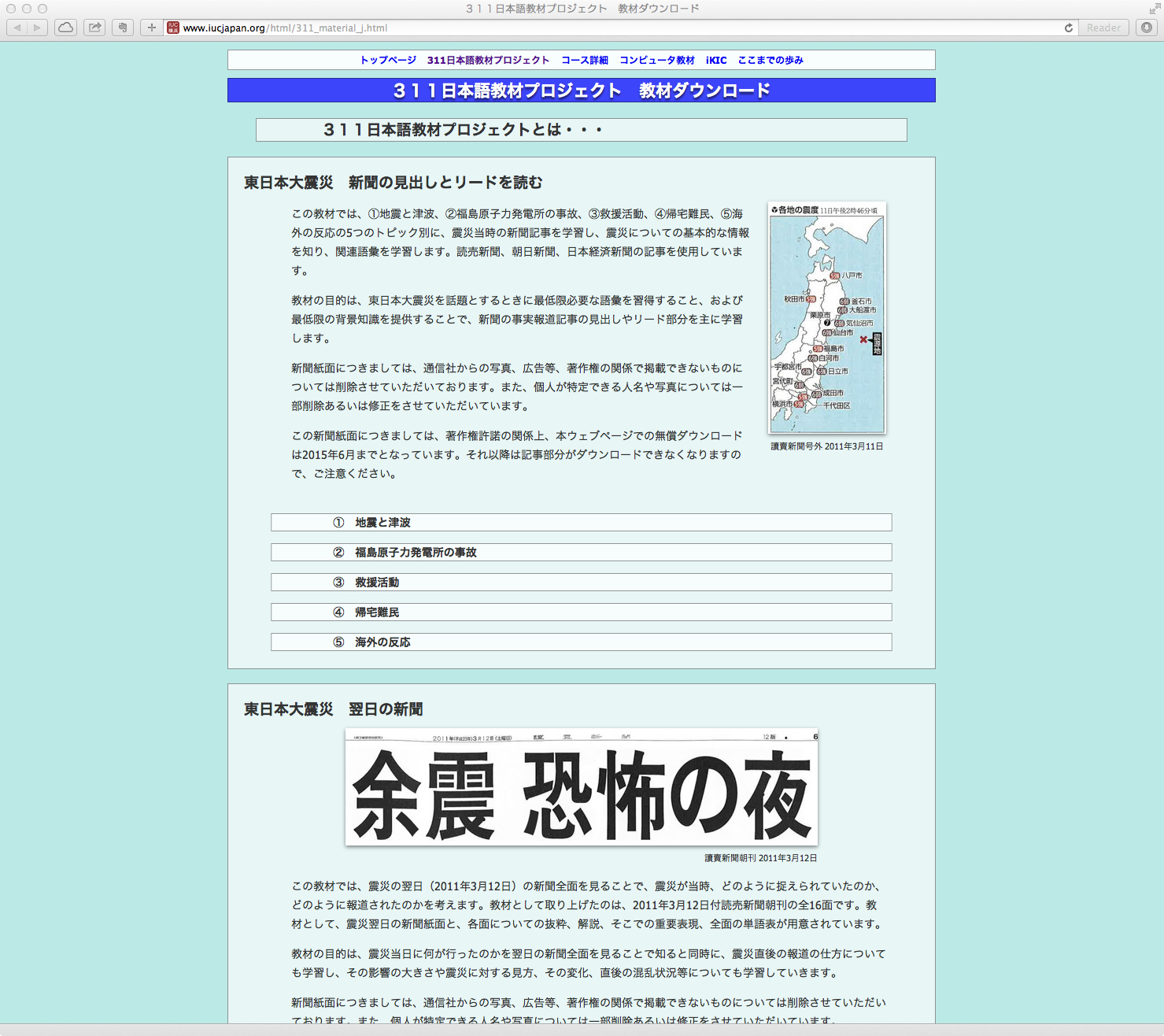アメリカ・カナダ大学連合日本研究センター [Inter-University Center for Japanese Language Studies], 311日本語教材プロジェクト [San ichi ichi nihongo kyōzai
 The 311 Japanese Teaching Materials Project is an educational resource that allows students to learn about 3.11 and its societal impacts while practicing their Japanese language skills. Created by the Inter-University Center for Japanese Language Studies, a Japanese language school for foreign scholars and professionals in Yokohama, the project provides a diverse set of primary sources online for instructors and students of Japanese learning. It also provides a wealth of teaching materials, such as vocabulary and phrase lists, grammar and critical reading worksheets, and discussion topics, to facilitate dialogue of the media coverage surrounding the disaster.
The 311 Japanese Teaching Materials Project is an educational resource that allows students to learn about 3.11 and its societal impacts while practicing their Japanese language skills. Created by the Inter-University Center for Japanese Language Studies, a Japanese language school for foreign scholars and professionals in Yokohama, the project provides a diverse set of primary sources online for instructors and students of Japanese learning. It also provides a wealth of teaching materials, such as vocabulary and phrase lists, grammar and critical reading worksheets, and discussion topics, to facilitate dialogue of the media coverage surrounding the disaster.
The first section is comprised of some of the major news headlines and ledes that first announced the disaster on March 11th, 2011. These short excerpts are meant to introduce students to the basic vocabulary and background of the disaster as foundations for further discussion. The materials in this section cover five topics: 1) the earthquake and tsunami, 2) the Fukushima Daiichi nuclear power plant disaster, 3) rescue efforts, 4) stranded citizens, and 5) foreign responses to the disaster. These topics continue into the second section, which presents several full-length newspaper articles from the day after the earthquake. These articles not only foster a deeper understanding of the disaster and its ensuing chaos, but they also raise important questions about the changing nature and influence of news.
The last two sections move away from journalistic sources to consider more personal experiences with 3.11. Two manga strips place their reader into the moment of the earthquake, demonstrating how individual people responded to uncertainty, disorder, and tragedy. These themes become amplified in the final section, which consists of an excerpt from the book Rise Once More! Kahoku Shinpō, Recordings of the Great East Japan Earthquake (Futatabi, tachiagaru! Kahoku shinpō, higashi nihon daishinsai no kiroku). By including these diverse, individual perspectives in its teaching materials, the project carefully balances the macro view of the disaster with more nuanced experiences on the ground.
In terms of Japanese language education, the materials are geared toward more advanced students; however, the first news section and the manga section could easily be catered to students at the intermediate level. The materials in their current state prioritize refining reading over listening skills. In this sense, the project could be enhanced by the inclusion of video clips, which were, after all, an integral part of the media coverage of the disaster. Despite this minor shortcoming, the project is an incredibly rich resource for Japanese language educators looking to inform students about the events surrounding 3.11 and to promote critical analysis of media responses to disaster.
Reference:
Kahoku Shinpōsha, ed. Futatabi, tachiagaru! Kahoku shinpō, higashi nihon daishinsai no kiroku. Tokyo: Chikuma Shobō, 2012.
Ashanti Shih, Yale University
![[Teach311 + COVID-19] Collective](https://blogs.ntu.edu.sg/teach311/files/2020/04/Banner.jpg)